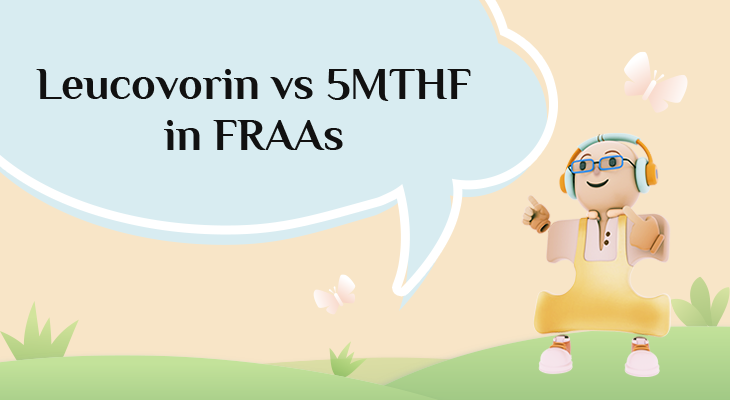
Introduction
A growing body of scientific evidence suggests a link between the consumption of cow’s milk and the production of autoantibodies that target the human folate receptor alpha (FRα). This process is driven by molecular mimicry, where the bovine FRα protein in milk is similar enough to the human version to trigger an immune response, but different enough that the resulting antibodies cross-react with and impair the function of the human receptor. This can possibly lead to a syndrome known as Cerebral Folate Deficiency (CFD), characterized by low levels of folate in the cerebrospinal fluid despite normal blood levels. CFD is particularly associated with certain neurological and developmental disorders, most notably a subset of Autism Spectrum Disorder (ASD). We all have heard of folate receptor autoantibodies and their negative effect on folate transport into the brain and cerebrospinal fluid. Might there be an interesting connection here? What are the implications that we should be aware of?
Folate and the Blood-Brain Barrier:
To understand the significance of this issue, one must first understand the critical role of folate and its transport mechanism.
- Folate (Vitamin B9): Essential for DNA synthesis, repair, and methylation—a crucial process for gene expression and neurological function. The developing and adult brain are highly sensitive to folate deficiency. We need this critical vitamin, especially in terms of the brain and central nervous system!
- The Blood-Brain Barrier (BBB): Protects the brain from circulating toxins and pathogens. However, it also restricts the passage of large molecules, including folic acid.
- The Folate Receptor Alpha (FRα): This is a high-affinity receptor located on the choroid plexus epithelial cells (the structure that produces cerebrospinal fluid). Its primary function is to bind folate from the blood, internalize it via endocytosis, and transport it into the cerebrospinal fluid (CSF), thus supplying the brain. It is a key gateway for folate entry into the central nervous system.
The Core Hypothesis: Molecular Mimicry
The central theory explaining how cow’s milk leads to FRAAs is molecular mimicry. This is a phenomenon where a foreign antigen (in this case, a protein from cow’s milk) shares structural similarities with a host antigen (human FRα), leading to an immune response that cross-reacts with the host’s own tissues.
A Plausible Step-by-Step Mechanism:
- Ingestion and Exposure: An infant or individual consumes cow’s milk. For this process to occur, there must typically be a compromise in the intestinal barrier (“leaky gut”), allowing intact or partially digested milk proteins to pass into the bloodstream. This compromised barrier can occur due to gastrointestinal inflammation, infection, immaturity (in infants), or other underlying conditions.
- Immune Recognition: The immune system, specifically B-cells and other antigen-presenting cells, encounters the bovine FRα protein in the bloodstream. Recognizing it as foreign, the immune system mounts an antibody response.
- Cross-Reactivity and Autoantibody Production: Due to the high degree of sequence homology (similarity in amino acid structure) between bovine and human FRα, the antibodies produced against the bovine protein are also capable of binding to the human FRα. These are now termed Folate Receptor Autoantibodies (FRAAs).
- Key Evidence: Studies have shown that the region of the FRα protein that binds folate is highly conserved across species. Antibodies generated against this specific region of the bovine protein are particularly likely to cross-react with the human receptor.
- Blockade of Folate Transport: The FRAAs circulate in the blood and eventually reach the choroid plexus at the blood-brain barrier. Here, they bind to the human FRα receptors.
- Two Mechanisms of Action:
- Blocking Antibody: The antibody physically blocks the binding site for folate, preventing the vitamin from attaching to its receptor.
- Binding Antibody: Even if it doesn’t directly block the site, the antibody’s binding can trigger the receptor to be internalized and degraded prematurely or simply interfere with its normal function.
- Two Mechanisms of Action:
- Result: Cerebral Folate Deficiency (CFD): The net effect is a severe reduction in the transport of folate across the blood-brain barrier. This leads to low concentrations of folate in the cerebrospinal fluid and brain, while folate levels in the blood remain normal. This specific condition is referred to as Cerebral Folate Deficiency.
Clinical Consequences of FRAAs and CFD:
The neurological consequences of CFD are profound because folate is vital for neurodevelopment and function.
- Symptoms of CFD: Can include developmental regression, seizures, movement disorders, insomnia, and cognitive impairment.
- Link to Autism Spectrum Disorder (ASD): Research spearheaded by Dr. Richard Frye and Dr. Edward Quadros has found a high prevalence of FRAAs (both blocking and binding types) in children with ASD and developmental disorders—often ranging from 47% to 75% in studied cohorts, compared to very low rates in neurotypical controls.
- Therapeutic Implication: This discovery led to a targeted treatment: leucovorin (folinic acid), a reduced form of folate that can bypass the blocked FRα pathway via other transport systems (e.g., the Reduced Folate Carrier RFC). Many children with ASD and positive FRAAs show significant improvement in communication, language, and behavior after folinic acid treatment.
Why Cow's Milk is Implicated:
This process is specific to cow’s milk for two reasons:
- Structural Difference: While bovine and human FRα are similar, they are not identical. The differences are sufficient for the bovine protein to be recognized as foreign by the human immune system.
- Timing of Exposure: The infant gut is more permeable in early life, a state designed to absorb antibodies from breast milk. If cow’s milk formula is introduced during this period of vulnerability, the likelihood of whole proteins entering the bloodstream may be increased.
Key Supporting Research:
- Quadros et al. (2005, 2009, 2013): Dr. Quadros’s team was among the first to identify and characterize FRAAs in mothers and their children with neural tube defects and later in ASD. They demonstrated the presence of these antibodies in blood and how they inhibit folate transport in vitro.
- Ramaekers et al. (2005, 2013): This group linked FRAAs to CFD syndrome in children and showed that oral folinic acid treatment could reverse the symptoms. They also provided evidence for the maternal transfer of these antibodies in utero.
- Frye et al. (2013, 2018): Conducted clinical trials showing that children with ASD and FRAAs significantly improved with folinic acid treatment compared to placebo, solidifying the clinical relevance of this mechanism.
Conclusion:
The consumption of cow’s milk, particularly in early infancy when gut permeability may be high, can act as an environmental trigger for the production of folate receptor autoantibodies (FRAAs) via molecular mimicry. These autoantibodies disrupt the primary transport mechanism for folate into the brain, leading to Cerebral Folate Deficiency (CFD). This deficiency can have severe neurological consequences and is a identified, treatable contributing factor in a significant subset of individuals with Autism Spectrum Disorder and other neurodevelopmental disorders. This research highlights the critical interplay between diet, immune function, and neurological health.
Reference:
Disclaimer: This report is for informational purposes based on current scientific literature. It is not a substitute for professional medical advice. Individuals with concerns about folate metabolism or neurological development should consult a healthcare provider.



